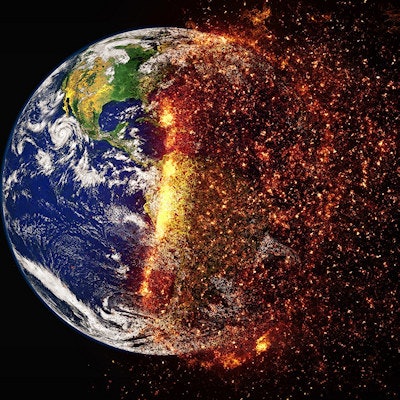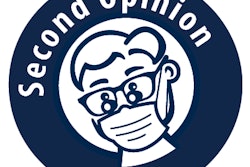
As wildfires rage in the West and other U.S. regions grapple with severe flooding, clinicians should explore how the consequences of global climate change may affect dentistry, according to an article published on September 15 in the International Dental Journal.
Dentists should understand the climate exposure pathways, such as poor air quality, illnesses, and extreme weather, and how they can affect patients' oral health conditions, including increases in caries, gum disease, and tooth dysplasia. Oral health professionals should focus on dental practice crisis preparedness after gaining insight into the potential problems. Currently, no published data about the effect of climate change on oral health exist, according to the article.
"In addition to delivering patient care, dental care delivery systems must demonstrate resiliency to survive extreme weather events and, as is profoundly known now with COVID-19, pandemics," wrote commentary author Dr. Donna Hackley, of the department of oral health policy and epidemiology at the Harvard School of Dental Medicine Office of Global and Community Health.
Earth is hurting
Human activity has caused greenhouse gas levels to soar, leading to rising average global temperatures, rising sea levels, flooding, and droughts during the past 100 years. These challenges lead to major health risks, including oral health risks, via heat stress, poor air quality, food and water insecurity, extreme weather events, vector-borne illnesses, and social factors.
Excessive heat exposure
Heat affects several drugs that are found in standard emergency kits for dental offices, including those that are given to manage patients' asthma episodes and allergic reactions, such as epinephrine. Heat affects the efficacy of these medications, which can be a huge problem for practices where there are climate control concerns. Heat stress also may increase antibiotic resistance. Less-effective antibiotics and emergency medications exposed to extreme heat may lead to greater risks of adverse medical events at dental offices, Hackley wrote.
Poor quality of air
Worsening wildfire seasons; longer, intense pollen seasons; increased air pollution; and increased ground-level ozone have been linked to significantly higher asthma rates. Drugs used to treat asthma, such as antihistamines, contain a major component of sugar and bronchodilators, which can lead to dry mouth. This can be problematic for these patients, considering xerostomia and sugar intake are risk factors for caries. Asthma also is linked to greater risks of caries, gingival inflammation, and more acidic saliva.
A lack of clean, safe water and food
Globally, 2.2 billion people lack safe drinking water and 4.2 billion people lack adequate sanitation services. Oral hygiene practices may fall behind or become impossible without safe, clean water. The result may lead to more cases of oral disease, Hackley wrote.
A lack of water and rising temperatures negatively affect crops and the growth of animals, which contributes to food insecurity and leads to more malnourished patients. Cancrum oris, a rapidly spreading orofacial gangrene, is linked to malnutrition, and early symptoms of the condition include gingivitis and ulcerative periodontal lesions. Enamel hypoplasia, dental caries, and delayed tooth eruption also are associated with malnutrition.
Extreme weather
As the globe continues to heat up, more severe weather events will occur. Water-borne illnesses due to flooding, disrupted food and medical supply chains, and other factors will leave dental care providers facing infrastructure challenges, like damaged offices, power outages, and a lack of access to patient records. These factors could limit patients' access to care and strain the finances of dental practices and their teams.
Vector-borne diseases
Vector-borne diseases, some of which cause oral manifestations, will rise and spread as surface air temperatures continue to climb. For example, the Zika virus may cause intraoral blood or bleeding under the skin, petechiae, mouth ulcers, or other ulcerative oral lesions. Lyme disease can present as headaches and nonspecific orofacial pain that may mimic temporomandibular joint disorders.
Social factors
Weather events, food and water insecurity, and economic changes will force more people to migrate from developing to developed nations. Many migrating populations lack access to health and dental care, leaving them at risk for many preventable, treatable diseases, including caries and gum disease.
6 steps to take now
In addition to knowing the oral manifestations related to risk factors from climate change exposure pathways, oral health professionals should be doing the following:
- Plan for power outages, dental record losses, office closures, and disrupted supply chains.
- Avoid overprescribing antibiotics.
- Add climate-risk questions to the medical history screening process to better understand possible renal, heart, and respiratory implications.
- Develop plans to use teledentistry to manage emergency patients and those with oral pain.
- Establish techniques to secure personal and professional finances.
- Think about in-office medication storage.
On a broader scale, dental teams should also be rethinking the use of environmentally harmful oral health-related items, like plastic toothbrushes and toothpaste, floss and mouthwash packaging, and patient treat bags with take-home samples. Continuing to use these items, as well as any other single-use plastics, contributes to environmental degradation, worsened health, health disparity, and climate change.
Climate change affects health, including oral health, Hackley wrote.
"Provider awareness is essential for recognition and management of climate impacts on individuals and communities," she noted.




















